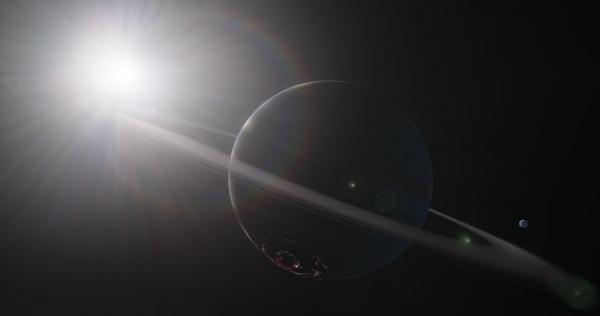BY LETTER
Lux (Kappa1 Ceti)
Unstabilized superflare star, occupied by various radiation resistant clades | |
 Image from Steve Bowers | |
| Shehnie and one of its paraterraformed moons during a superflare | |
Lux - Data Panel | |
| System | Names: Lux Location: - Distance from Rana: 7.536 ly (J2000) - Distance from Sol: 30.26 ly (J2000) - Constellation: Cetus |
|---|---|
| Star | Names: Lux, Kappa1 Ceti, 96 Ceti, Gliese 137 (GJ 137), HD 20630, HIP 15457, HR 996 Physical characteristics: - Mass: 1.037 x Sol - Radius: 0.958 x Sol - Luminosity: 0.903 x Sol (bolometric) - Temperature: 5,749 Kelvin - Spectral type: G5 V - Rotation period: 9.2 days - Age: 300 million years System: 1) Hake: Terrestrial OxyHermean LapiMinervan Achlysian Semi-major axis = 0.219 AU, Orbital period = 36.76 days, Eccentricity = 0.078, Mass = 0.016 x Earth, Radius = 0.244 x Earth 2) Weuun: Terrestrial LapiMinervan Achlysian Semi-major axis = 0.307 AU, Orbital period = 61.01 days, Eccentricity = 0.081, Mass = 0.588 x Earth, Radius = 0.847 x Earth 3) Tebadad: Terrestrial LapiMinervan Achlysian Semi-major axis = 0.416 AU, Orbital period = 96.24 days, Eccentricity = 0.064, Mass = 0.613 x Earth, Radius = 0.867 x Earth 4) Veve7etli1: AcidiTerrestrial CereYdratian AquaAbyssal Semi-major axis = 0.686 AU, Orbital period = 203.8 days, Eccentricity = 0.008, Mass = 1.367 x Earth, Radius = 1.181 x Earth 5) Dsagec: HydroTerrestrial CereYdratian AquaAbyssal Semi-major axis = 1.114 AU, Orbital period = 1.155 years, Eccentricity = 0.004, Mass = 2.081 x Earth, Radius = 1.453 x Earth 6) Rouk Eib: HydroNeptunian CereYdratian AquaCytherean Semi-major axis = 1.921 AU, Orbital period = 2.615 years, Eccentricity = 0.010, Mass = 7.141 x Earth, Radius = 2.424 x Earth 7) Shehnie: HydroJovian HydrogeoBarian Semi-major axis = 3.606 AU, Orbital period = 6.723 years, Eccentricity = 0.014, Mass = 109.8 x Earth, Radius = 10.75 x Earth |
| Reached | 1503, by Parthene colonists |
The geological activities on most of the inner rocky planets have been regulated, allowing them to be utilized in various ways. The exception is the Hermean world Hake, which was used by the local civilizations as a giant canvas for their artworks. Volcanic eruptions and quakes frequently rock the planet, occasionally destroying and burying some of the artworks. This was seen by the locals as part of the process, and is tolerated. Beyond them lie three ocean worlds, including Dsagec, a water-rich steam world that is home to an extensive biosphere of mechanical-style organisms.
A single gas giant planet, Shehnie, orbits further out. Its clouds have been stained dark green characteristic of floating microscopic planktons, which are some of the most complex organisms seeded upon this world. Four orbital rings surround the planet at various angles, supporting a number of boostbeam facilities which redirect incoming cyclers using mass transferred from the planet via space elevators. The sites of early Terragen habitation in this system, primarily in form of habitats established by Parthene colonists that arrived in 1503, can be found embedded within the icy shells and subsurface oceans of some of its many satellites; others have been heated and paraterraformed into little ocean worlds, serving as homes to a diverse assortment of aquatic sophonts. A large multipurpose structure known as the Paddan is positioned at Lux-Shehnie L1, serving as both a computronium node for transapients (but also available to modosophonts), and an energy collector for illumination of Shehnie's satellites.
Beyond it lies a vast debris disk that has been partially converted into a large number of orbital bands, some of which incorporated the largest habitats in the system as their components. A notable example of such habitat is Coccoo'oo Labyrinth, a 600 kilometer-radius microgravity habitat in the form of tangling meshes of diamondoid 'wires' several hundred meters thick, living within it are tens of billions of sophonts (a significant fraction of which regularly live outside the the controlled environment habitats carved into the 'wire', and travel along the surface or hopping between threads, as alternatives to using trains or mindstate transmission) and countless vacuum ecosystems.
Appears in Topics
Development Notes
Text by Anders Sandberg
additional material by Steve Bowers and The Astronomer, 2021
Initially published on 03 December 2001.
additional material by Steve Bowers and The Astronomer, 2021
Initially published on 03 December 2001.
Additional Information
References - Mass: https://arxiv.org/abs/1112.3316






